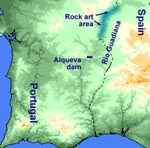 13 – April 2001 special issue devoted to the Guadiana Rock Art 13 – April 2001 special issue devoted to the Guadiana Rock Art
8.2.2002 – Black Day for Rock-Art
INTERNATIONAL FEDERATIONS OF ROCK ART ORGANIZATIONS
 Guadiana map This is a black day in the history of global endeavours to preserve the cultural heritage of humanity, and in more ways than one. For one thing, it condemns one of Europe’s greatest art treasures to permanent destruction. The Guadiana valley rock art, one of the continent’s largest art galleries, comprises the artistic documents of countless anonymous artists representing millennia. They will first be covered by the waters of the Alqueva dam, and then, as the dam ages, by billions of tonnes of gravel and mud. They will be lost well and truly beyond recovery.
But not only will this irreplaceable art corpus never be seen again, the hasty attempts of untrained and inexperienced people to record this immense record within just a few months are of no value to scholars and scientists. It is cultural vandalism to destroy such a historical record, but to do so without adequately recording it for posterity is an even more serious matter. When the Taliban destroy a carved rock statue, we are shocked. But at least we have records adequate enough to recreate the monument. The Portuguese government destroys its cultural heritage without such minimal efforts to save at least the scientific information it holds.
But what is perhaps the most unsavoury aspect of the total destruction of the Guadiana rock art and other monuments in the valley is that this state vandalism is occurring with the full approval of the state’s agencies responsible for the protection of Portuguese rock art and other antiquities. Indeed, the Portuguese Institute of Archaeology defended and advocated the destruction, stating that the rock art is unimportant. Moreover, the European Union is heavily implicated in this large-scale vandalism of historical monuments, it has provided much of the funds, obviously without ensuring that the project will not involve excessive damage to the environment.
This is indeed a black day. The Taliban are regarded as terrorists. The cultural terrorists of Portugal carry briefcases instead of arms, and they are on the payroll of the state. Portugal paid dearly for their mistakes in 1995. When history repeats itself so needlessly it is truly a tragedy.
Robert G. Bednarik
President of the International Federation of Rock Art Organisations
(published 8 February 2002)
|
















Leave a Reply